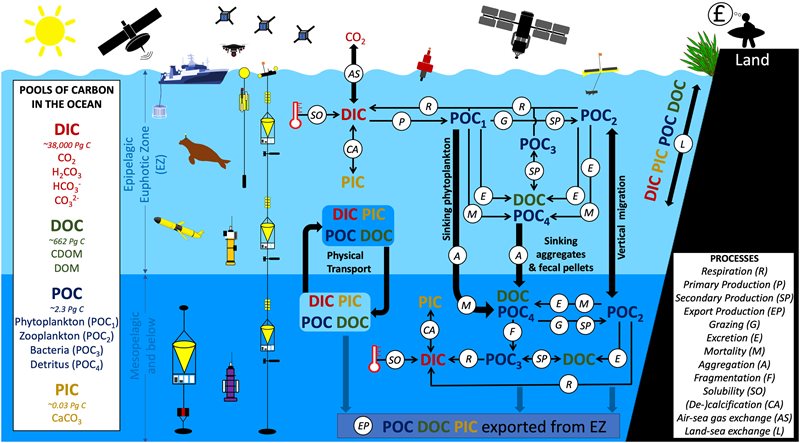The ocean carbon cycle is a vital part of the global carbon cycle. It has been estimated that around a quarter of anthropogenically-produced emissions of CO2, caused from the burning of fossil fuels and land use change, have been absorbed by the ocean. On the other hand, significant advances have been made recently to expand and enhance the quality of a wide range of Remote Sensing based products capturing different aspects of the ocean carbon cycle.
BICEP will bring these developments together to increase understanding of the ocean biological pump and its processes and interactions with the Earth system.

Figure above: Pools, fluxes and processes that form the ocean biological carbon pump (OBCP), and current methods used to monitor them. Bold black text and thick black arrows represent the key export pathways and interactions with other domains (land and atmosphere). Global stocks of the different carbon pools in the ocean are given in the box on the left; the four major kinds of pools – DIC, DOC, POC and PIC – are given in different colours. This figure is from Brewin et al. (2021) and has been inspired by, and builds on, two earlier figures, one from the CEOS carbon from space report (CEOS, 2014) and the other from the NASA EXPORTS plan (Siegel et al., 2016).
To achieve this goal, the BICEP project will first synthesise the current state of knowledge in the field. From this information a set of scientific requirements and essential Remote Sensing products will be produced which will be used to generate an extensive BICEP dataset.
The dataset will be used as input into a novel, satellite-based characterisation of the ocean biological carbon pump, quantifying the pools and fluxes, how they vary in time and space, and how they compare with ocean model estimates. This satellite-based Ocean Biological Carbon Pump analysis will then be placed in the context of carbon cycling in other domains of the Earth System, through engagement with Earth System modellers and climate scientists.
The work will be delivered by a consortium of twelve international Institutes, led by Plymouth Marine Laboratory (PML, Plymouth, UK) and composed of
top-level scientists, with collective expertise on Remote Sensing, statistical modelling, ocean carbon cycling, theoretical ecology and Earth System science.
International Workshop
A workshop building on the success of
The Colour and Light in the Ocean (CLEO) workshop, will be organised to engage the international community in a discussion on how BICEP work could be extended and integrated with results from other components of the ocean carbon cycle (e.g. CO
2 air-flux and ocean acidification) and large international Earth System analysis, such as the Global Carbon Project and assessments made within the International Panel of Climate Change (IPCC).